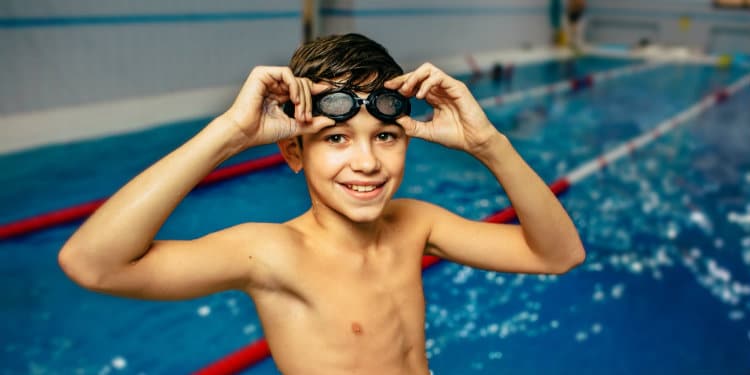Keeping the Ball Off Your Eye – Sports and Eye Safety
Whether your roost is with the Dux, the Chix, the Maroons, or another area school, there is no lack of athletic opportunities through the fall and winter.
Many of these sports stress the importance of proper protective gear: helmets, guards, pads—but have you taken full consideration of how to best protect your student athlete’s eyes?
According to the American Academy of Family Physicians, more than 40,000 eye injuries are suffered per year during sports. The good news is that most of them can be easily prevented.
Taking a few precautionary considerations, just as you would against other types of sports injuries, can make a big difference in helping prevent unwanted eye trauma. Different sports have different needs to consider, and we will go into some of these while offering some general tips as well.
Keep Your Eyes Behind Protectors
Blunt trauma is the most common cause of an eye injury. There tend to be objects flying around during games, of course!
In most cases, a bruise or “black eye” is going to be the result of the impact. It’s not pretty, but usually not going to result in serious damage. Some cases are more severe, and may result in a fracture of the bone beneath the eyeball (orbital blowout fracture), a detached retina, or direct damage to the eyeball itself.
For basketball, soccer, and tennis (as well as any other sport where you smack things around with a racquet), we recommended a set of sports eye guards. For tennis, the ball is the main concern (and sometimes a racquet, honestly). For basketball and soccer, their large balls can land a direct hit on the eye, but a more common concern is being in close proximity to a lot of flying elbows and fingers!
If your child wears prescription glasses, we recommend they be fitted with prescription eye guards as well. There are other options that can fit around a pair of glasses which may be suitable for certain activities, but a prescription set will provide optimal all-around protection.
A good pair of eye guards should have protective lenses that either stay in place upon impact or can only pop outward. Lenses that detach toward the eye can be dangerous. Subsequently, eye guards without any lenses at all are not recommended for sports and may not fully protect from harm.
Check to see whether the eye guards you are considering have been tested for sports use. Safety indicators you should look for include:
- ASTM F803 approval. This means they have been tested and found worthy in withstanding common impacts from sports use.
- A polycarbonate composition. This material is not only 10 times more resistant to impacts than other plastics, but can also be seen through without skewing vision.
- A scratch-resistant coating. This is very common nowadays, but eyewear without this will end up getting scuffed and more difficult to see out of over time.
Finding the Right Fit
Fit will also naturally be crucial for both safety and making sure wearing guards isn’t a miserable experience. There should be enough cushioning along the bridge of the nose and brow to be comfortable and prevent digging into the skin. The strap should also be adjusted and tested to make sure it isn’t a bother.
As is natural for growing kids, there may be the temptation to buy equipment that allows “room for growth.” This is a bad idea for eye guards, as an improper fit—either too loose/big or too tight/small – will reduce the amount of protection provided. Just imagine the guards sliding up upon impact, or digging even further into the face. Not good!
Eye guards are still recommended if football is the game of choice, but they should be worn in conjunction with a polycarbonate shield that’s attached to the faceguard.
Ultimately, a good pair of standard eye guards will usually cost between $20-$40. Prescription eye guards tend to run around $60.
Eye Protection while Swimming
While impacts are not as common in swimming as in other sports, you can still receive an errant kick to the face. More problems occur from irritation or infection from what’s in the water.

If your child is spending a lot of time training and competing in the water, a good pair of swim goggles will be essential for keeping eyes comfortable and safe. You will want to look for polycarbonate lenses just as with other sportswear.
The type of goggles best suited for competition are the Swedish variety with two “cups” that suction over the eyes. In fact, a pair that fits well will easily make a seal over the eyes without having to rely on the strap.
You will still need to use the strap, however. Both it and the goggles should not fit so tightly that your child looks like a raccoon upon taking them off. If you have found a pair of goggles that fit well across the face (a treasured discovery!) but have trouble with their strap, replacing it with a fabric-coated bungee can make a huge difference.
Seeing to a Great Sports Season
Whether your child is hitting the field, the courts, or the pool, the right eye protection can make for increased safety and increased confidence.
If you have questions about protective eyewear, or want to discuss prescription options, the staff of Sight Eye Clinic is happy to address all your pediatric eye care needs.
Call our Zeeland office at (616) 772-2020 to schedule an appointment. If you prefer, you may also send questions and appointment requests through our online contact form. A member of our office will reach back to you as soon as available.
